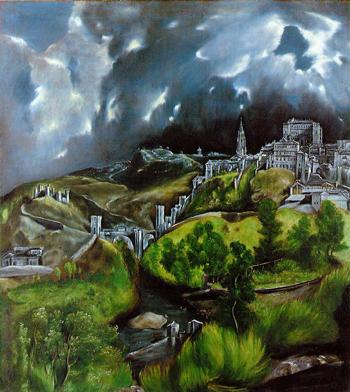| Search Art Prints | ||||||||||||||||||||
| Search Artists | ||||||||||||||||||||

|
||||||||||||||||||||
|
|
|||||||||||||||||||

View of Toledo

|
Not only is View of Toledo one of the most famous landscapes ever painted, it is also one of the first. Around the time it was painted, independent landscapes were just beginning to emerge as a legitimate subject in European art. It is a testament to El Greco's extraordinary talent that such a pioneering work remains one of the most dramatic of its kind.
Before painting View of Toledo, El Greco had exhibited inclinations towards landscape painting—the backgrounds of many of his paintings stand out as proto-landscapes. The roots of View of Toledo lie in an earlier work by El Greco, St. Joseph and the Christ Child: an identical view of the city appears in that painting's background. It is appropriate, then, that View of Toledo is essentially a spiritual portrait of the town; its advent lies in a religious painting.
The painting is not actually of the whole city. The view we are presented with is the part of the city built on and above a hill that slopes down to the Tagus River below, spanned by the famous Alcántara Bridge. Furthermore, El Greco changed the positions of some buildings, to make them stand out more or be visible in the first place. Other than excluding some of the city and making minor alterations to the placement of some buildings, however, the painting is very true to life.
The most remarkable aspect of the painting, of course, is the sky above. The entire city is transformed. Rays of shimmering light barely penetrate the clouds, adding to them a mysterious intensity. Arid, stony, sun-drenched Toledo is subjected to the blackness and radiance of a powerful storm, its awesome power dwarfing the grandeur of the city below.
The emotional and spiritual power of this painting helped earn El Greco the posthumous title of proto-Expressionist in the early twentieth century.











